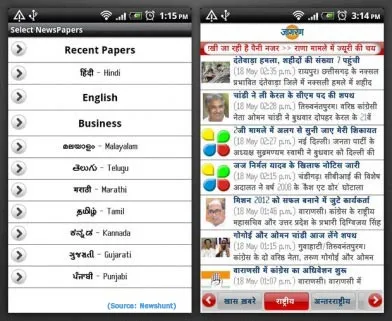Is there Value in Building a Business around Online Vernacular Content?
There are two levels to this question:
a) Is there value in vernacular content?
b) Is there value in online vernacular content?

a) The first one is a clear YES, which wasn’t the case a few years back. In 2007, English publication readers constituted 10% of total print media readership, but garnered 60% of the total print ad-pie. Today, English still constitutes 10% of readers, but its share of the ad-pie has come down to 40%. In the same period Hindi grew from 20% to 30% of the ad-pie. To put things in perspective, the print-ad pie is ~$1B today, so Hindi print alone is at $300M of ad-revenue and growing at 17-18% annually. More data in a recentarticle in FE.
According to media buyers’ estimates, during 2007-09, the ad rate commanded by English newspapers was roughly 10x that of non-English dailies. This rate has contracted to about 8x and is further expected to come down to 5x or 4x in the next three years.
The above is also the driver for investments and growth in Hindi print. E.g.Blackstone’s investment in Jagran and Nalanda’s investment in DB Corp.
b) Value in online vernacular content is not showing in terms of monetization yet. Online advertising is gaining traction but it is mostly English today. However, it is encouraging that vernacular is building up readership – Dainik Bhaskar recently announced 200M monthly pageviews. Advertising spend on any media tends to inflect after reach (readership) crosses a threshold, and the signs for online vernacular are in the right direction.
Thus the answer to the question in the title of this post is “Yes, it seems so”, but it won’t be clear for some more time. Of course, when the answer is obvious to everyone, the opportunity no longer exists.
Takeaways for entrepreneurs:
- There is an opportunity in vernacular: Online vernacular readership is increasing and will increase faster as internet and mobile-data access continue to penetrate deeper beyond the English-speaking population.
- Monetization will take longer: Be prepared to keep a lid on the costs while the market shapes up. Good news is that the online ad-ecosystem is in place for English and given will bring $$$ to vernacular if there is an arbitrage opportunity in pricing.
- Local plays an important role in vernacular: 60%+ of ad-revenues in vernacular-print come from regional sources (regional fmcg brands, education institutes, local government, etc). The content too has a very local taste – print publications customize their content every 25 kms to fit into local dialects and preferences. So keep localization in mind in terms of content and as well as monetization.
- Think mobile: With cost of devices and access continuously falling, mobile might be the primary channel for accessing vernacular content inIndia, unlike English.
- Define your space: Large offline publications will always be faster and cost efficient in building content. You need to define your space but still be meaningful to a large enough population.
- Think out of the box, especially if you are looking to raise venture funds. Content production is a linear businesses. Can there be a platform play where the effort/cost of building content is not directly proportional to content monetization?
- Finally, keep an eye on vernacular even if you run an online transaction business (like ecommerce). If vernacular audience is valuable to an advertiser (online or offline), it is likely valuable to you as well, so don’t close your doors on them by having an English-only website. The “access” value proposition of ecommerce is also more suited to the non-metros ofIndia, which constitute ~50% of the orders today.
Please add your thoughts in the comments section.







